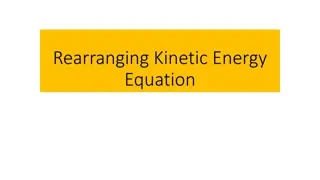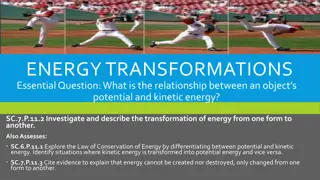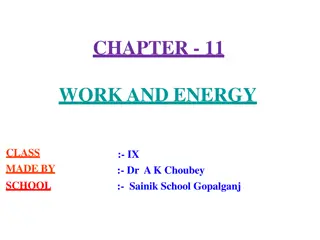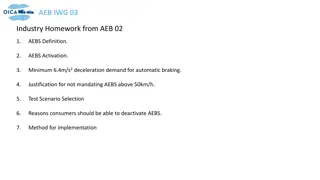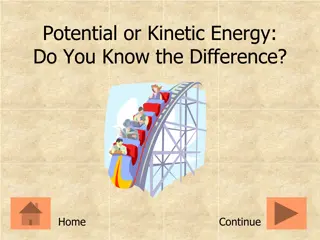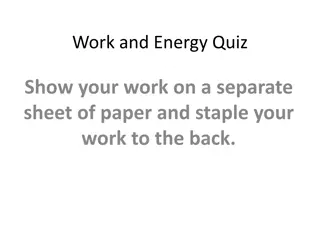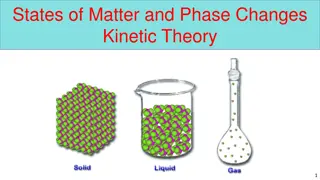Collision Scenarios and Kinetic Energy Analysis
In these scenarios, different air track gliders and objects collide head-on, resulting in their velocities and kinetic energy changing. The post-collision speeds and the lost kinetic energy are calculated for each scenario. Additionally, a bullet collides with a block of wood, leading to an evaluation of velocities and kinetic energies before and after the collision, as well as the missing kinetic energy transformation into heat.
Download Presentation

Please find below an Image/Link to download the presentation.
The content on the website is provided AS IS for your information and personal use only. It may not be sold, licensed, or shared on other websites without obtaining consent from the author.If you encounter any issues during the download, it is possible that the publisher has removed the file from their server.
You are allowed to download the files provided on this website for personal or commercial use, subject to the condition that they are used lawfully. All files are the property of their respective owners.
The content on the website is provided AS IS for your information and personal use only. It may not be sold, licensed, or shared on other websites without obtaining consent from the author.
E N D
Presentation Transcript
1. A 230. gram air track glider going 0.210 m/s collides head on with a 450. gram glider going the other way at 0.780 m/s. The gliders then stick together. What is their post collision speed? How much kinetic energy is lost in the collision? (0.445 m/s, 0.0746 J) Already have it
2. A 370. gram air track glider going 0.980 m/s collides with a 450. gram glider going the same way at 0.120 m/s. The gliders then stick together. What is their post collision speed? How much kinetic energy is lost in the collision? (0.508 m/s, 0.0751 J) Already have it
3. A 460. gram air track glider going 0.320 m/s collides with a stationary 450. gram glider. The gliders then stick together. What is their post collision speed? How much kinetic energy is lost in the collision? (0.162 m/s, 0.0116 J) Already have it
4. A 160. gram air track glider going 0.150 m/s collides head on with a 230. gram glider going the other way at 0.540 m/s. The gliders then stick together. What is their post collision speed? How much kinetic energy is lost in the collision? (0.257 m/s, 0.225 J)
5. A 480. gram air track glider going 0.520 m/s collides with a 630. gram glider going the same way at 0.180 m/s. The gliders then stick together. What is their post collision speed? How much kinetic energy is lost in the collision? (0.327 m/s, 0.0157 J)
6. A 4.25 gram bullet going 613 m/s strikes a 216 g block of wood and sticks in it without emerging. What is the velocity of the bullet and block of wood after the collision? What is the kinetic energy of the bullet before the collision? What is the kinetic energy of the bullet and block combo after the collision? How much kinetic energy goes missing? What happens to the missing kinetic energy? (11.8 m/s, 799 J, 15.4 J, 783 J, turns to heat)
7. A 12.5 g bullet going 516 m/s horizontally sticks into a 1.625 kg block of wood hanging from a very long string. What is the velocity of the block right after the collision? To what height does the block rise on the string? (3.94 m/s, 0.791 m)
8. A 12.5 g bullet going horizontally sticks into a 1.625 kg block of wood at rest hanging from a very long string. It makes the block rise to a height of 0.426 m. What was the velocity of the bullet and block combo right after the collision? What was this bullet s original velocity? (2.89 m/s, 379 m/s)
9. A 2.85 g bullet going 523 m/s vertically upward strikes the bottom of a 517 g block of wood at rest and sticks in the block without emerging. What is the velocity of the bullet and block combo right after the collision? To what height above its original position does the block rise after the collision? (2.87 m/s, 41.9 cm) Already have it
10. A 2.90 g bullet going straight up at some speed strikes the bottom of a 170. g block of wood at rest, and sticks in it without going through. The bullet and block combo fly 11.4 m up into the air. What was the post collision speed of the combo, and what was the bullet's original speed? (15.0 m/s, 892 m/s) Already have it
11. A 5.20 g bullet going horizontally strikes a 810. g ballistic pendulum at rest and sticks in it, making it swing up to a height of 31.0 cm. What speed were the block and bullet going just after the collision, and what was the bullet's speed before the collision? (2.47 m/s, 387 m/s) Already have it
12. A 3.10 g bullet going horizontally at 630. m/s strikes a 930. g ballistic pendulum at rest, and sticks in it making it swing up to some height before going back down. What was the velocity of the bullet and block just after the collision? To what height did the bullet and block combo swing? (2.09 m/s, 22.3 cm) Already have it
13. Yet another 12.5 g bullet going 516 m/s goes right through the 1.625 kg block of wood hanging from a very long string, and is going 314 m/s after it goes through the block. What is the block s velocity after it passes through, and to what height does the block rise? (1.54 m/s, 0.121 m)




